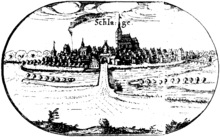Sławno
Sławno | ||
|---|---|---|
 Medieval brick gate (Brama Koszalińska) | ||
|
Car plates ZSL | | |
| Website | http://slawno.pl | |
Sławno [ˈswavnɔ] (Kashubian: Słôwno, German: Schlawe) is a town on the Wieprza river in Middle Pomerania region, north-western Poland, with 12,511 inhabitants (2019). It is the administrative seat of Gmina Sławno, though not part of it. The town is also the capital of Sławno County in West Pomeranian Voivodeship.
Sławno is a railway junction on the major Gdańsk–Szczecin line, with access to secondary importance connections to Darłowo and Korzybie. It is also a stop on the European route E28 running parallel to the south coast of the Baltic Sea between the cities of Koszalin and Słupsk.
History

The territory became part of the emerging Polish state under

Swietopelk II prevailed, his son
Duke Wartislaw IV enfeoffed Peter von Neuenburg of the
During World War II, the Polish resistance was active, and Polish underground press was distributed in the town.[5] Sławno suffered heavy destruction during the war. With the defeat of Nazi Germany in 1945, its German population was expelled in accordance with the Potsdam Agreement and it was handed over back to Poland.
From 1975 to 1998, it was administratively located in the Słupsk Voivodeship.
Population
- 1791: 1,682 inhabitants
- 1852: 4,382 inhabitants
- 1875: 5,141 inhabitants
- 1910: 6,620 inhabitants
- 1939: 9,746 inhabitants
- 1947: 4,800 inhabitants (estimated)
- 1960: 8,600 inhabitants
- 1970: 10,800 inhabitants
- 1975: 11,500 inhabitants
- 1980: 12,700 inhabitants
- 2002: 15,000 inhabitants
- 2019: 12,511 inhabitants
Notable people
- Franz Mehring (1846–1919), German journalist, Communist and a Revolutionary Socialist
- Hans-Martin Majewski (1911–1997), German composer of film scores
- Erica Wallach (1923–1994), American-German political activist and teacher
- Arwed Imiela (1929–1982), German serial killer
- Otto Mellies (1931-2020), German actor
- Wolfgang Weber (born 1944), German footballer
- Marcin Wasilewski (born 1975), Polish pianist and composer
- Agnieszka Włodarczyk (born 1980), Polish actress and singer
Twin towns – sister cities
 Cles, Italy
Cles, Italy Ribnitz-Damgarten, Germany
Ribnitz-Damgarten, Germany Rinteln, Germany
Rinteln, Germany Ząbkowice Śląskie, Poland
Ząbkowice Śląskie, Poland
Sławno is also a partner city with:
 Trento, Italy
Trento, Italy
References
- ^ "Population. Size and structure and vital statistics in Poland by territorial division in 2019. As of 30th June". stat.gov.pl. Statistics Poland. 2019-10-15. Retrieved 2020-02-14.
- ^ Labuda, Gerard (1993). "Chrystianizacja Pomorza (X–XIII stulecie)". Studia Gdańskie (in Polish). Vol. IX. Gdańsk-Oliwa. p. 47.
- ^ Erich Hoffmann, Die Bedeutung der Schlacht von Bornhöved für die deutsche und skandinavische Geschichte, in: Zeitschrift des Vereins für Lübeckische Geschichte und Altertumskunde, vol. 57. 1977. p. 9-37, here p. 15.
- ^ Christiansen, Eric (1997). The Northern Crusades (2nd ed.). Penguin Books. pp. 105–108. ISBN 0-14-026653-4.
- ISBN 978-83-8229-411-8.
- ^ "Miasta partnerskie". slawno.pl (in Polish). Sławno. Retrieved 2020-03-04.






